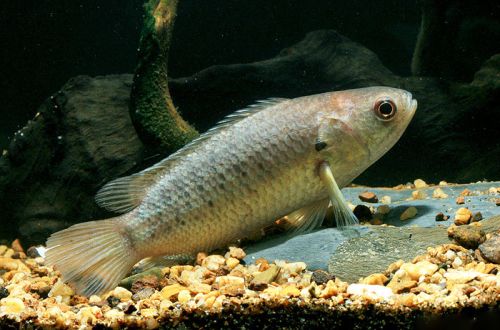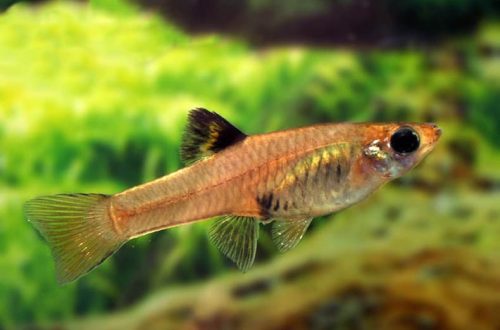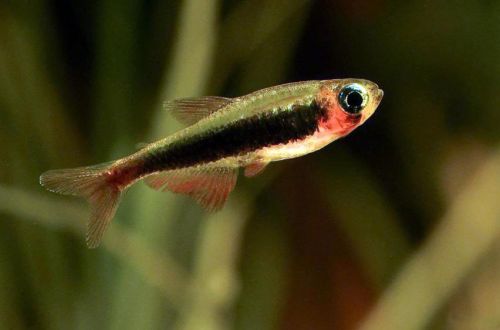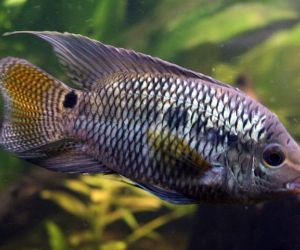
Creeper fish
Anabas or Creeper Fish, scientific name Anabas testudineus, belongs to the Anabantidae family. Extremely hardy and unpretentious look. It has an amazing ability for fish to move on land, using its pectoral fins to lift its body off the ground, and its tail to push. Thus, it moves over short distances in case of drying up of the reservoir. Widely distributed throughout Asia, but not very popular in the aquarium hobby due to its large size and nondescript coloration. In poor countries, it is often bred as a forage fish.

Contents
Habitat
Widely distributed throughout Southeast Asia, also introduced to Australia and the Pacific Islands. It lives everywhere in almost all available water bodies: swamps, lakes, backwaters of rivers and their tributaries, canals, rice fields, large temporary puddles in the forest canopy, etc.
During the wet season, as extensive coastal areas are flooded, it may swim far from the main channel. When the water begins to recede, the fish often find themselves in isolated puddles and backwaters. Sometimes, in order to survive, it makes long transitions of hundreds of meters overland in search of a new place. Moves with the help of pectoral fins and lateral movements of the tail and rear of the body. Such trips are not regular, but only in a situation of complete drying up of the reservoir. In extreme situations, Anabas goes into a state of hibernation for several weeks, burrowing into the ground.
Brief information:
- The volume of the aquarium – from 200 liters.
- Temperature – 15-30°C
- Value pH — 5.5–8.0
- Water hardness – soft to hard (2-26 dGH)
- Substrate type – sandy
- Lighting – subdued
- Brackish water – no
- Water movement – little or no
- The size of the fish is up to 20 cm.
- Meals – mostly meat
- Temperament – inhospitable
- Keeping alone or in pairs male / female
Description
Adult individuals reach a length of up to 20 cm, and some specimens up to 25-30. Females are somewhat larger than males. The coloration is gray or brown with barely visible dark specks and two black dots at the base of the tail and behind the gill cover. The fins are rounded and strongly shifted back towards the tail.
Food
Leads a predatory lifestyle, feeds on small fish, invertebrates and molluscs. In a home aquarium, it will accept large live and frozen foods. Most breeders have been able to accustom to protein-based dry kibbles with herbal supplements. Be sure to check your diet before buying.
Maintenance and care, arrangement of the aquarium
The minimum size of an aquarium for one fish starts from 200 liters. Creeper fish are able to adapt to different conditions, so the choice of decoration is completely up to the aquarist’s imagination, subject to some recommendations, namely the presence of shelters, soft substrate and areas with dense vegetation.
Anabas is also not picky about the hydrochemical composition and water temperature. The only thing you should pay attention to is the level of illumination and the internal flow. The equipment is adjusted in such a way as to provide subdued light and, if possible, to reduce the movement of water to a minimum.
Aquarium maintenance comes down to regular cleaning of the soil from organic waste, weekly replacement of part of the water (10–15% of the volume) with fresh water.
Behavior and Compatibility
Not suitable for the general aquarium, given the size of adults and predatory nature. Any small fish will be eaten. Joint keeping is only allowed with species of similar size, such as Pacu, in a spacious tank.
There is no exact information on intraspecific aggression, which is explained by the great diversity and wide distribution of a particular species. Depending on the region, some representatives behave quite friendly towards their relatives, while others, on the contrary, fiercely attack a potential rival. It is noted that with an increase in temperature, the behavior of even calm Anabas becomes more aggressive.
Breeding / breeding
One of the few representatives of labyrinth fish, which does not show parental care for future offspring. During the mating season, a reddish tint appears in the coloration of males, especially on the ventral fins and tail, and dark specks become more noticeable. The females are noticeably rounded. After a short courtship, spawning begins, accompanied by a kind of “embrace”, hundreds of eggs and seeds are released at the culmination point. In total, during spawning, their number can reach several thousand. The eggs are left to themselves and float freely on the surface. After 24 hours, fry 2-3 mm long appear.
Breeding in home aquaria is practically impossible without hormonal injections, which are widely used in commercial fish farming.
Fish diseases
The main cause of most diseases is unsuitable living conditions and poor-quality food. If the first symptoms are detected, you should check the water parameters and the presence of high concentrations of hazardous substances (ammonia, nitrites, nitrates, etc.), if necessary, bring the indicators back to normal and only then proceed with treatment. Read more about symptoms and treatments in the Aquarium Fish Diseases section.





